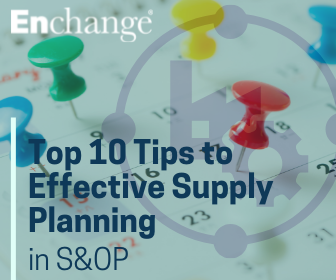The Enchange Supply Chain House; the one-stop shop for all the elements you need to achieve supply chain excellence.
In successful FMCG companies, Sales & Operational Planning (S&OP) is the flexible glue that holds your processes together ensuring demand and supply are balanced along the chain and most importantly, sees everyone operate to the same set of unambiguous sales, volume and financial numbers.
In the previous article we looked at the Top 10 elements necessary for effective Demand Planning within the S&OP process. Continuing the planning theme, this article discusses the detailed activities, processes and decisions required for an effective Supply Review meeting as part of that S&OP process.

Top 10 Tips – Supply Review
- Supply Review Policy. Is there is a concise written Supply Planning Policy including a fixed schedule for monthly meetings covering the process, purpose, activities, participants responsibilities and expected results? Are participants empowered to contribute and "Silence Indicates Approval" is the modus operandi? Is ownership of the policy abundantly clear and routine policy reviews are carried out?
- Supply Process & Procedures. Do effective procedures exist to ensure supply of materials from suppliers, intermediates and manufactured product for dispatch and distribution to customers? Is supply routinely on time and in the correct quantities to support the needs of the production and distribution plans?
- Planning Horizons. Does the supply review process include a fully constrained plan for an adequate time horizon - e.g. months 1 to 3, at least? Is there the option to resolve any supply issues in this review? Is there a forward-looking unconstrained outline plan for months 4 to 12 (ideally 18+) to support the S&OP process?
- Inventory Management. Are stock levels maintained optimally to ensure there is sufficient raw materials (RM) and packaging materials (PM) available for manufacture? Are there enough finished goods (FG) to satisfy normal market demand, while being careful not to over-stock? Is your inventory securely stored and counted periodically?
- Rough Cut Capacity Planning (RCCP). Is there a capacity planning process based on RCCP? Does capacity requirements planning include balancing of required capacity with demonstrated output? Is a capacity control process used to measure and manage factory throughput and batch queues? Is a load or yield factor that recognises loss due to utilisation and known inefficiencies used and maintained? Do capacity planners and production management meet regularly to resolve capacity issues and drive improvement?
- Master Production Scheduling (MPS). Is the master production scheduling process continually managed to ensure a balance of stability and responsiveness as per the needs of the forecast and customer service? Is the MPS reconciled with the production plan resulting from the Sales & Operational Planning process (S&OP)?
- Materials Planning & Control. Is there a materials planning process that maintains valid schedules and a control process that communicates priorities? Do you operate with formal manufacturing schedules, dispatch lists, supplier schedules and a Kanban/Production Wheels mechanism?
- Materials Requirements Planning (MRP). Is MRP run as frequently as required to maintain valid schedules but not too frequently to generate unhelpful 'noise’? Is an accurate (>98%), well-structured and integrated Bill of Materials (BOM) maintained?
- What If Scenarios (WIS). Are WIS used to evaluate alternative operating and supply plans and develop contingency plans for materials, people, equipment and finances? Is RCCP used to support alternate sources of production, e.g. make versus buy? Are MRP and Distribution Requirements Planning (DRP) utilised where applicable, to evaluate alternative planning options and the resultant impact on inventories? Do you use simulation programmes to support S&OP supply commitment decision making?
- Supplier Relationships & Planning. Are supply and suppliers intricately integrated into company operations? Are supplier partnerships supported by mutually beneficial SLAs that are seen to work? Is there a supplier planning process that provides visibility for key items covering an adequate time horizon? Are key suppliers considered as critical partners?
Supply Planning is a key activity in meeting the demand derived from the S&OP process. Increasingly, producers and suppliers work ever more closely together to set the foundation for mutual market success through S&OP excellence.
Read more articles on Supply Chain Excellence and Route To Market on our website where you can also subscribe to our updates.
Finally, feel free to use any of our contact routes including Live Chat, if you have any questions about how the Enchange Supply Chain House can assist your journey to supply chain excellence.







